The Difference Between Dutch And French Ovens
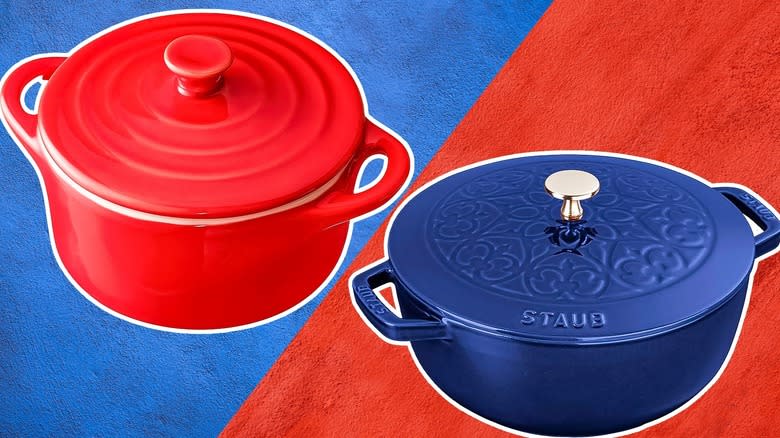
To a budding home cook, a Dutch oven can seem like an intimidating piece of cookware that must be mastered. Made of cast iron, it comes with a tight-fitting lid and a heavy base — features that make it handy for braising and roasting meat, poaching chicken, making casseroles, deep frying, and some baking. However, what many people may not know is that Dutch ovens are also useful for everyday cooking, from sauteing to boiling water. Buying a high-quality model can be a splurge, but its usefulness and versatility make it a worthy long-term investment.
When shopping for a Dutch oven, you might find similar-looking cookware labeled French ovens. Inspired by the original Dutch version, a French oven is just as multi-functional and hardworking in the kitchen. What sets it apart is its enamel coating. This additional layer to the cast iron makes a difference in how the cookware must be looked after.
Another difference between the two is that French ovens are manufactured in France. Identifying them as French was a marketing strategy to distinguish them as higher-end merchandise. However, the name didn't catch on, which is why French-made enameled pots are labeled as Dutch ovens in the U.S. and many other parts of the world, which is also where the confusion lies.
Ultimately, picking the right one depends on what you typically cook and what you can afford. Read on to learn how the lack or presence of an enamel coating affects how you use a cast iron pot.
Read more: Ina Garten's 12 Best Cleaning Tips For A Mess-Free Kitchen
What Is A Dutch Oven?
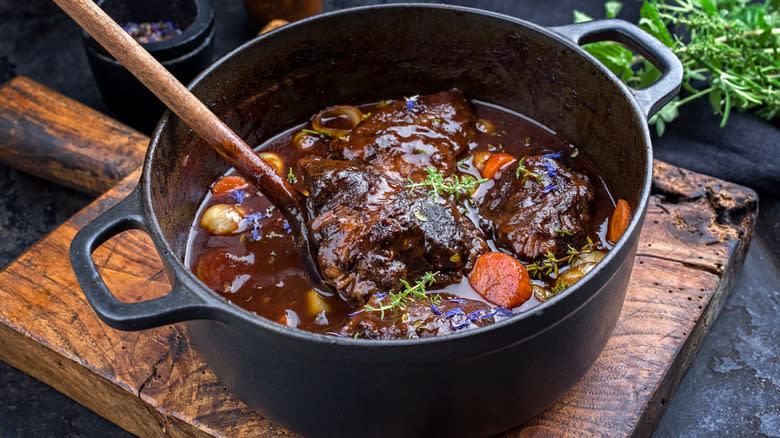
As mentioned, Dutch ovens are heavy pots with tight lids commonly used for slow cooking. Some brands also make models made of stainless steel and ceramic but traditionally, this cookware is made of cast iron.
There are a few theories regarding how this pot got its name, but the most popular one is that it was named after the Dutch process of using dry sand molds to cast iron for making pots. Developed during the Dutch Golden Age in the 17th century, it resulted in cookware with smoother surfaces and, therefore, improved functions, especially heat distribution. In 1704, an Englishman named Abraham Darby learned the process during a trip to Holland and brought it back to England. Within four years, he had further developed and patented the process and was soon making cookware sold throughout his home country.
After British settlers in the U.S. discovered how durable and useful the Dutch oven was, they added features to further improve its design. These included a tight-fitting flat metal lid, short legs, and a wire handle for easier outdoor cooking.
What Is A French Oven?
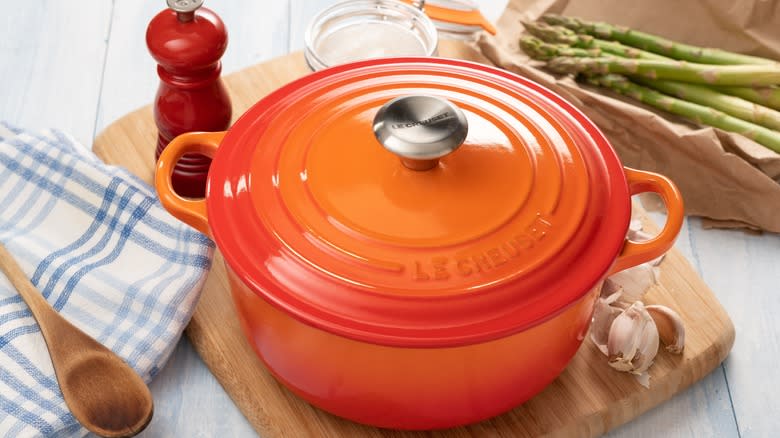
The Dutch oven's utility inspired the French brand Le Creuset to make an improved version of it — specifically, one that wouldn't chip, crack, or stain. In 1925, it introduced the French oven or cocotte. With the cast iron coated with richly pigmented porcelain enamel, the company became a pioneer in manufacturing colorful and enameled cast iron pots. Its first hue was a vibrant red-orange aptly dubbed Flame (or Volcanique in France), and it eventually became Le Creuset's signature color. The brand has since produced a wide range of colorful cookware, but that first hue was La Creuset's tribute to the craftsmanship of casting iron.
While the name French oven isn't as widely recognized, these enameled pots are very popular because of how beautiful they look on countertops, kitchen shelves, and dining tables. The enamel also makes them semi-nonstick, which makes cleanup easier.
Le Creuset and Staub, another French company, are known for producing cookware that's sold at higher price points. However, this doesn't mean that all enameled Dutch ovens are more expensive than non-enameled ones. French legacy brands have maintained the operations of their respective factories within their home country, thus they've been able to sustain the production of high-quality products that sell for steeper prices. Similar products from companies whose manufacturing process happens offshore fall within a more affordable price range, but they still function as sturdy and useful cookware, especially when you take proper care of them.
There Are Different Types Of Dutch Ovens
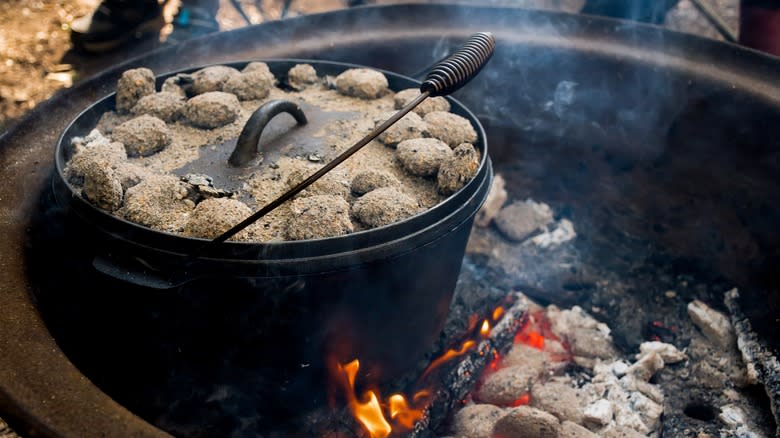
Dutch oven is an umbrella term for various kinds of cast iron heavy pots. Aside from the enameled French version, you also have the camping Dutch oven. This non-enameled variant typically comes with short legs and a wire handle so it can be placed atop camping stoves or suspended over a campfire. Some models also have flat, lipped lids where hot coals can be placed to ensure better heat distribution from top to bottom when cooking outdoors.
There's the double Dutch oven as well. It comes with a deeper lid that can be flipped and used as a skillet, which is why this cookware is also sometimes called a 2-in-1 Dutch oven.
Dutch ovens come in round and oval shapes. Round ones tend to be smaller than their oval counterparts, but since their bottoms are of the same shape and size as standard stove-top burners, these ones heat up faster and more evenly. It's a good idea to pick one that has high walls to prevent food and liquids from spilling over or splattering.
On the other hand, oval-shaped Dutch ovens can fit larger pieces of meat, making them ideal for roasting a whole chicken or pork loin. Aside from following their natural curvature, these pots also provide enough space for air to circulate so the meat gets beautifully browned. Oval Dutch ovens are also ideal for baking wet dough if you want your loaves to come out in the traditional oval shape.
A New Dutch Oven Requires Seasoning Before Use
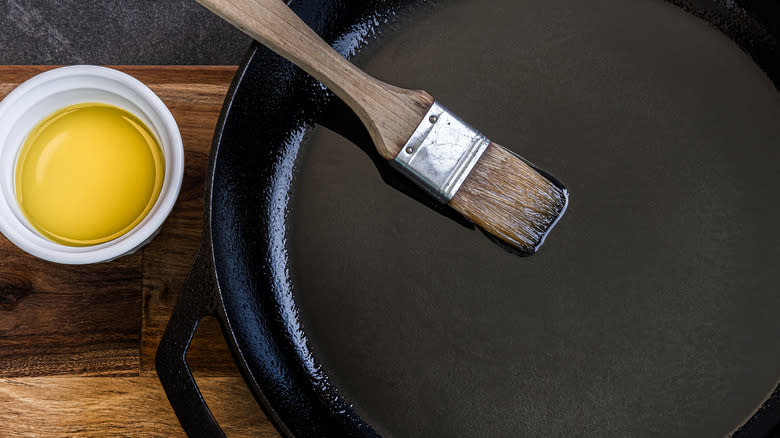
A Dutch oven can withstand heavy-duty cooking, but it also requires care and proper maintenance. Unlike its enamel-coated French version, this one requires seasoning to keep food from sticking to its surface. You must season your new Dutch oven right after you've purchased it by coating its inside with oil and then heating it. This process is called polymerization, and it creates a protective layer that will prevent your pot from developing rust.
Even though there are pre-seasoned models available in the market, taking this extra precaution before using your new cookware is a step you shouldn't miss to ensure its longevity. For the best maintenance, season your Dutch oven two to three times a year.
French ovens, in comparison, don't require seasoning since their enameled surface no longer has the pitted texture of raw cast iron. However, this smoother countenance doesn't guarantee that food wouldn't stick to the pot. Cooking with a French oven still requires using a sufficient amount of oil to coat its bottom to keep ingredients from adhering to the cookware.
French Ovens Heat Slower Than Dutch Ovens
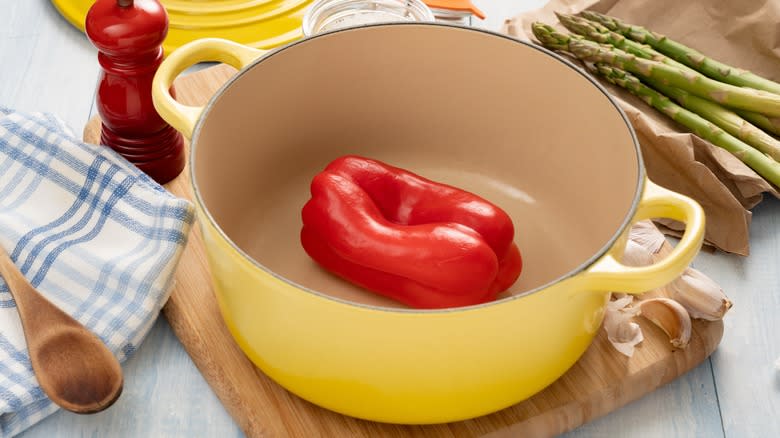
A big factor in Dutch ovens' utility is how they ensure the even distribution of heat. The layer of enamel added to French ovens further helps with this, according to assistant professor Liheng Cai at the University of Virginia's School of Engineering & Applied Science. Cai explained to the Washington Post that the enamel adjusts to the uneven nature of a stove-top burner so the heat gets distributed better. The downside, however, is that this extra layer makes the French oven's cast-iron material less heat-conductive.
While high-quality brands guarantee the durability of their enameled pots, lower-quality ones are more prone to chipping and cracking when handled improperly. Since cast iron heats up fast when placed in direct heat, it tends to expand quickly as well. This could cause stress on the enamel coating, leaving it vulnerable to cracking. Protect your French oven from this risk by not exposing it to rapid temperature changes, such as placing it while still empty on an open burner or plunging it in cold water while still hot. When cooking with it, ensure its base is well-coated with oil, fat, or any liquid ingredient. Avoid letting a dish boil for too long that it starts to dry up. Prolonged exposure to high heat will also cause the enamel to crack.
Use Cooking Oil With A High Smoke Point In Dutch Ovens
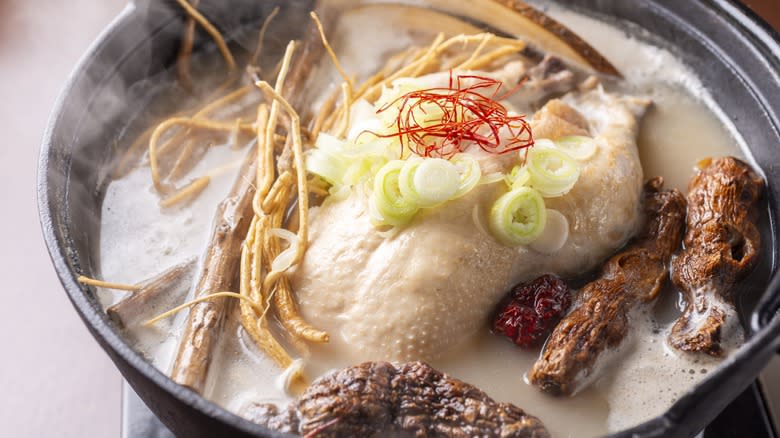
Cast iron retains heat well, which means the oil or fat you use to cook with your seasoned Dutch oven will be left exposed to high heat longer. This raises its risk of burning, especially if you use butter, which has the lowest smoke point of all cooking fats. Instead, go with avocado or peanut oil since they can withstand both high heat and slow cooking. You should also use oil with a high smoke point when seasoning a Dutch oven.
Cooking fats with moderate smoke points such as canola, grapeseed, and extra virgin olive oil work better with French ovens due to their enamel coating. Still, you must remember to keep the heat to medium at most. We've already mentioned how high heat can lead to enamel cracking; another drawback to using high temperature is the food getting glued to the bottom of the pot and potentially burning.
French Ovens May Be Better For Cooking Acidic Dishes
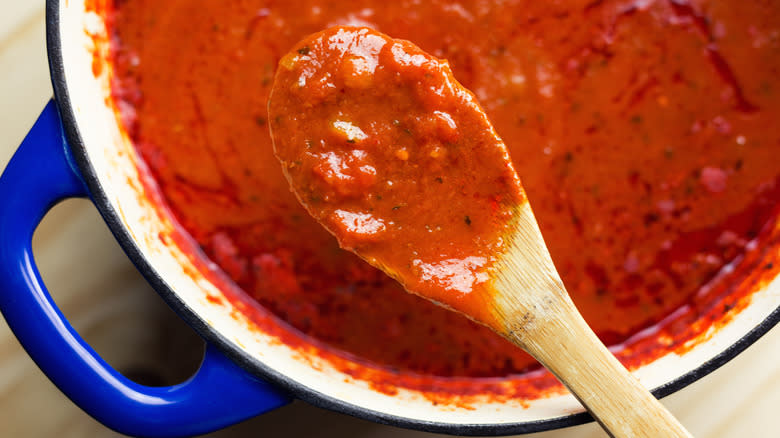
Vinegar is a wonderful ingredient for heightening flavors. However, cooking vinegar-based entrees in a seasoned Dutch oven may corrode its protective layer and trigger the cast iron to impart a metallic taste and color to food. In fact, anything acidic, even tomatoes and wine-based sauces, may cause the same reaction. This isn't a problem with French ovens since enamel isn't as reactive as metal. It's also non-porous, creating a seamless layer that holds up well against acidic food.
Some advise keeping the cooking time to under 30 minutes with either type of cookware. However, this isn't practical when cooking slow-cooked dishes, but the lower temperatures should ensure they withstand the extended time. With French ovens, prolonged exposure to acidic ingredients can stain the enamel coating. Don't let acidic dishes sit too long in the pot, either. And once your cast iron pot has cooled down, rinse and wash it by hand.
If food particles have adhered to the base of your Dutch or French oven, let it sit overnight filled with hot water mixed with dishwashing soap or baking soda. The next day, slough off the stuck food pieces with a sponge (avoid using steel wool) then rinse and dry the pot completely before storing it. It's also advisable to re-season your Dutch oven as soon as you can. And if you're looking for more helpful advice, read our tips for cooking with an enameled Dutch oven.
Read the original article on Tasting Table

 Yahoo Lifestyle
Yahoo Lifestyle 
